Recipes

What is a Recipe?
Recipes combine one or more ceramic materials in specific proportions. Mixed together, those ingredients become something new—a throwing clay body, a glossy glaze, or a vivid underglaze.
The recipe below is a classic recipe called “Leach 4321”. Leach 4321 is often used as an example because its recipe is very simple and it works well:
Leach 4321

Because the recipe lists proportions, you can treat the amounts like percentages. Leach 4321 is made up of:
- 40% Potash Feldspar,
- 30% Silica,
- 20% Whiting, and
- 10% Kaolin,
For a combined total of 100%.
It is not unusual to see recipes that do not total to 100. Often, recipes in workshops are written down as batches rather than 100% proportions. For example, Leach 4321 can also be written as:
- 4000g Potash Feldspar,
- 3000g Silica,
- 2000g Whiting, and
- 1000g Kaolin,
For a combined total of 10,000g.
It’s the same recipe as above, just multiplied by 100 and measured in grams. Potters often keep a favorite batch size handy to simplify mixing (10,000g is common for a large glaze bucket).
Note: All recipes are measured by weight, not volume!
Recipe Basics
Learn how to bookmark, print, export, and make batches of recipes:
Create a Recipe
Please see the Calculator section
Batches
batch, noun
- A quantity required for or produced as the result of one operation: made a batch of cookie dough; mixed a batch of cement. link
Because recipes list proportions, you can weigh them in any unit—ounces, grams, kilograms, whatever matches your scale.
For convenience, ceramicists usually stick to the Metric System . Batches of recipes are measured in grams and kilograms. Small test batches are usually only 100 or 200 grams, while batches for daily studio use can be 10 or 20 kilograms.
More information about mixing up batches: Mixing Test Recipes
The Batch Calculator
Underneath each recipe listing is a Calculate Batch box. Enter a number and Glazy will calculate the ingredient amounts for that batch size.
Here we calculate a batch size of 100:
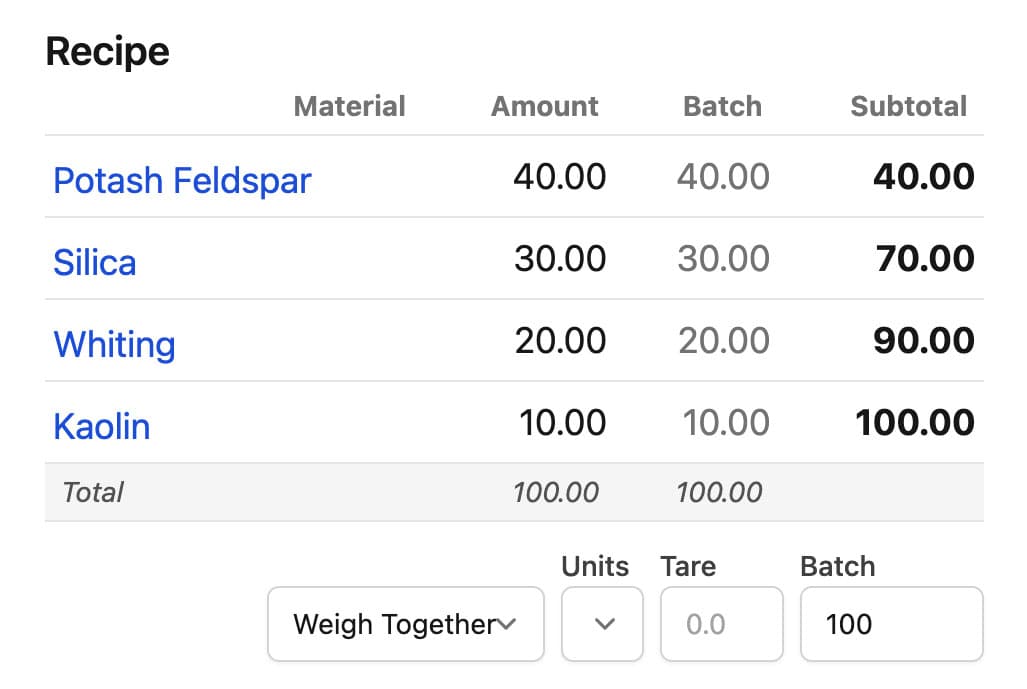
And here we calculate a batch size of 200:

Base Recipes & Additional Ingredients
Recipes are often split into a base recipe and additional ingredients.
Think of pizza: the base is the dough and sauce, while toppings are the extras. For glazes, the base is a plain glaze; colorants or opacifiers are the extras that change its look.
Below is the same Leach 4321 recipe with 1% Red Iron Oxide added:
Leach 4321 Celadon

The name changes because that small addition turns it into a celadon.
When you calculate a batch, additives sit on top of the base batch. A 100g base plus 1g Red Iron Oxide makes the total 101g.
Batch Costs
Glazy can calculate the price of a batch of a recipe. First, make sure you have entered your material inventory costs in the Inventory:

Screenshot of the Glazy Inventory page showing the price of materials. Although Glazy shows a dollar sign, the currency is whatever your prices are in. Be sure to enter both the price and the unit of measurement. In this inventory you can see that Mahavir Potash Feldspar costs $0.59 per pound.
Then, when you calculate a batch, Glazy will show the cost of the batch:
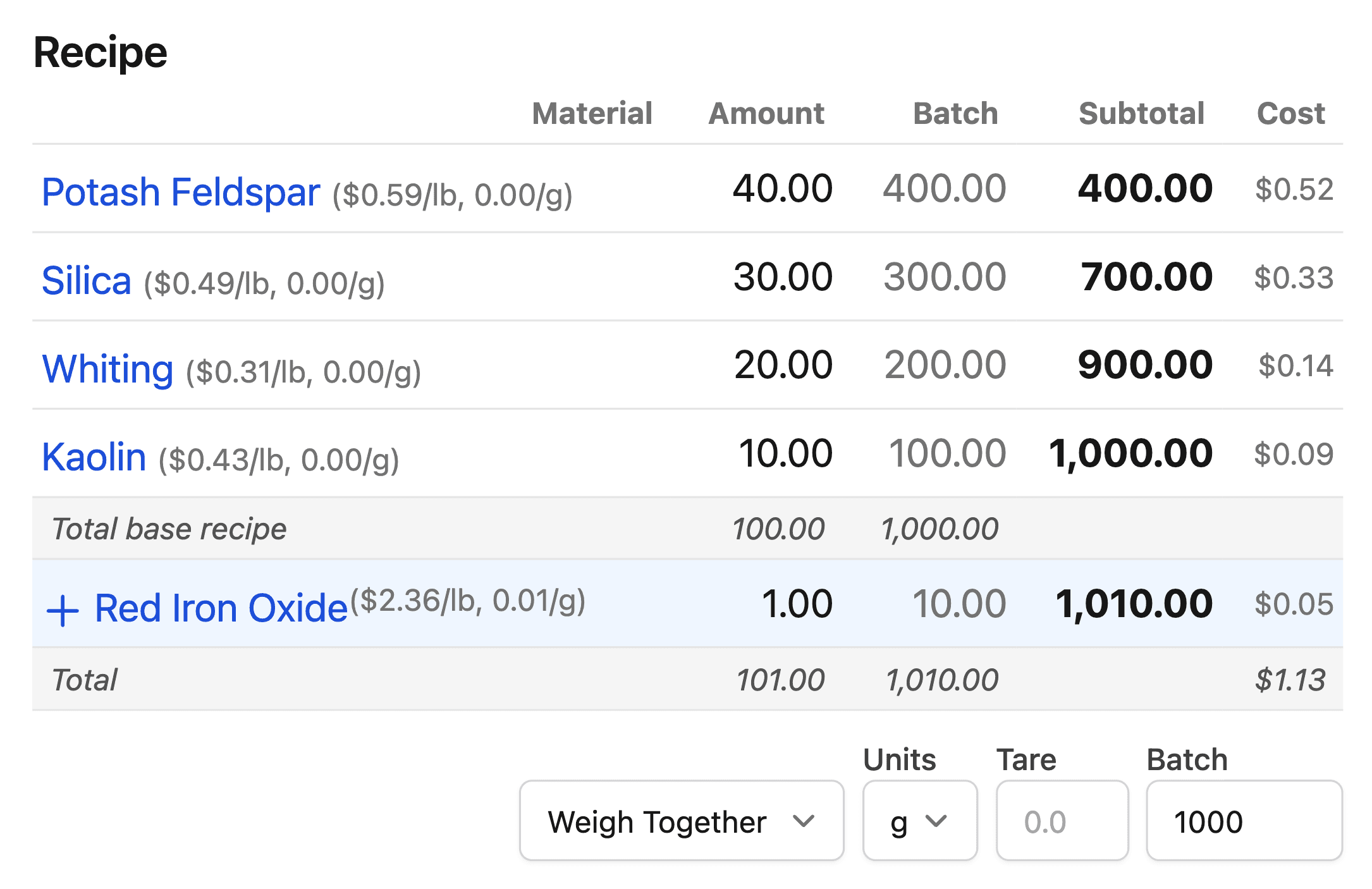
Screenshot of the Glazy Batch calculator showing the cost of a batch. For this batch, the amount is 1000 and the units are grams (g), i.e. 1 kilogram. The total cost for the batch is $1.13.
Recipe Information
Each Recipe has descriptive information, or metadata, that describes it. In general, the more metadata is added to a recipe, the easier it is to categorize, compare, and search recipes.
Glazy uses structured data. Rather than freeform tags, you pick from a set list of categories. If you do not agree with a category, please contact Glazy and we can discuss changing it.
Type and Subtype
Defining a useful, universal taxonomy for glazes is very difficult. Glazy’s types are based on both historical types and glaze characteristics. For a full list of Glazy’s types and subtypes, see Clay & Glaze Types
When creating a recipe please specify a type and subtype. If glazes are categorized more specifically with subtypes like “Blue Celadon”, “Black”, and “Clear” then it is much easier for both the Glazy software and users to navigate the recipes.
Privacy: Public vs. Private Recipes
When you create a Recipe or Material in Glazy, it is unpublished and private by default. When you are ready to share your recipe with the world, you can click the Publish button. This will make your recipe public and searchable by other Glazy users. Before you publish, make sure the recipe is complete and accurate so that yourself and others can rely on it. Public recipes are visible to everyone in the Glazy community and appear in search results. Private recipes are only visible to you, the creator.
You can unpublish a Draft or Testing recipe at any time (making it private again), but once a recipe is set to Production or Discontinued, it cannot be unpublished if it was made public. This is to ensure that others who rely on your public recipe can trust that it will not disappear unexpectedly.
Status
Both Materials and Recipes share a four-step status system: Draft → Testing → 🔒 Production → 🔒 Discontinued.
Locked Recipes: Production and Discontinued recipes are “locked” meaning they cannot be edited or deleted. This is to ensure that you don’t accidentally change your important recipes, and that public recipes that are shared with others remain consistent.
Draft
Draft is the pre-testing stage. Use it to capture early ideas, placeholder analyses, and photos before you are ready to invite others to try the recipe. Draft recipes remain fully editable and can be published or unpublished as you refine them.
Testing
Testing indicates that a recipe is still in development and not actively used in the studio. It can still be modified or deleted. Be cautious when bookmarking other users’ public Testing recipes, as they may change without notice.
Production
Production recipes are considered well-tested and reliable. To ensure consistency for everyone using or bookmarking the recipe, Production recipes are locked and cannot be edited or deleted after being marked as such. You can trust that these recipes won’t change unexpectedly. A photo is required for a recipe to be marked as Production. Only recipes with a status of Production appear in the default Glazy search results. Important: Once a recipe is marked as Production, its status cannot be changed back to Testing.
Discontinued
Discontinued recipes are those you no longer use, perhaps because an ingredient isn’t available anymore or the recipe didn’t work as expected. Like Production recipes, Discontinued recipes are locked and cannot be edited or deleted once marked. Important: Once a recipe is marked as Discontinued, its status cannot be changed back to Testing.
Country
It can be useful to associate a recipe with a Country if the ingredients and firing are specific to a location. For example, many traditional Chinese materials are tied to specific mine and kiln locations.
The Unity Molecular Formula (UMF) Chart
See Also: Unity Molecular Formula (UMF)
Each Glazy Search and Recipe page contains a Unity Molecular Formula (UMF) Chart. This chart shows the recipes closest to the current recipe. The current recipe is represented by a star symbol, while neighboring recipes are represented by a circle.

The UMF Chart defaults to a Silica (x-axis) and Alumina (y-axis) chart, which is the most commonly used type of chart when looking at glaze chemistry. But you can easily change the two axes to any combination of oxides.
The Stull Chart
Overlayed on top of the UMF Chart is the Stull Chart. Here is the original Stull Chart, first published by R. T. Stull in Transactions of the American Ceramic Society, Volume 14, pages 62-70 .
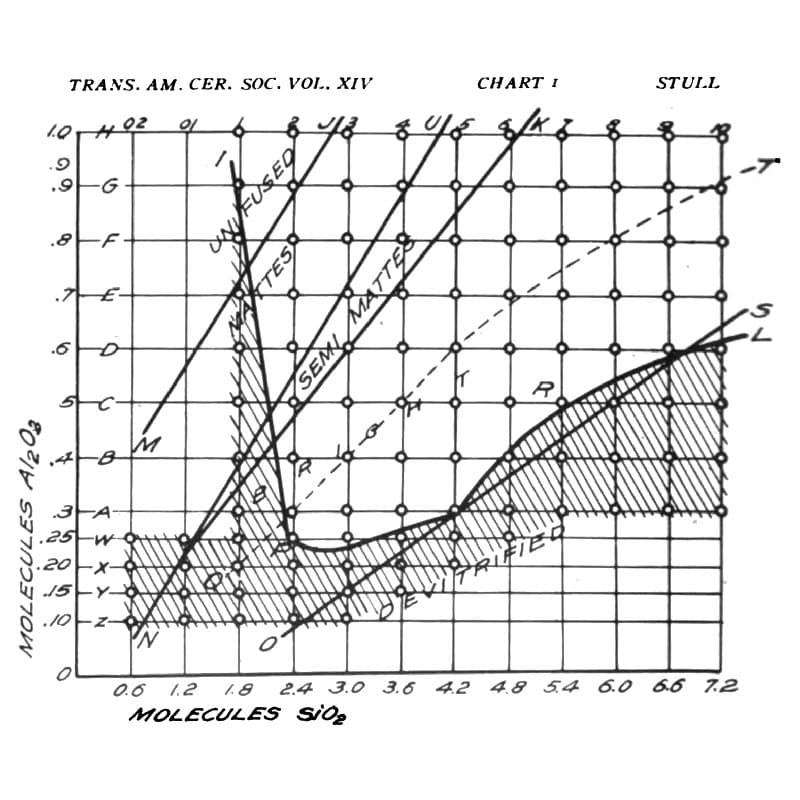
This is a slightly updated version of the Stull Chart which is a little more readable:

The Stull Chart has six regions:
- Unfused & Under-fired: Glazes in this region have either too much Alumina (Unfused) or too much Silica (Under-fired) are not fired to maturity.
- Matte: Glazes in this high-Alumina region are typically “true” matte glazes.
- Bright: In this middle-region, glazes are typically glossy glazes. Most of the recipes in Glazy, especially clear glazes, can be found in the Bright region.
- Crazed: Glazes in this region tend to have a crazed surface.
Caveats
- The Stull chart was created for glazes with a flux ratio 0.3 R2O: 0.7 RO and fired to cone 11. There may be variations in the chart for glazes with different flux ratios fired at different temperatures.
- The Stull chart does not show or predict firing temperature. So, just because a recipe point lies in the “Bright” region does not mean it will be a glossy glaze at your firing temperature.
- Because crazing is a function of both the glaze and clay body, the Stull Crazing Region is highly dependent upon not only the glaze chemistry but also that of the clay body. So the Crazing Region will be quite different depending upon these factors.
- In spite of all these limitations, the Stull Chart Regions of Unfused & Under-fired, Matte, Semi-matte, and Bright still hold true at a number of different temperatures with a range of flux ratios and flux types. For futher information about how to apply the Stull Chart, please see the work of Matt Katz (some articles linked below).
More Stull Chart information: Robust Mid-Temperature Glazes and How Glazes Melt.
Glazy Stull Chart
Due to space limitations in the website, the Glazy Stull Chart looks slightly different than the above chart, lacking the region names and color codings, but otherwise is the same. Each point on the chart represents a recipe. In this example you can see that most of the recipes fall within the Stull “Bright” region.
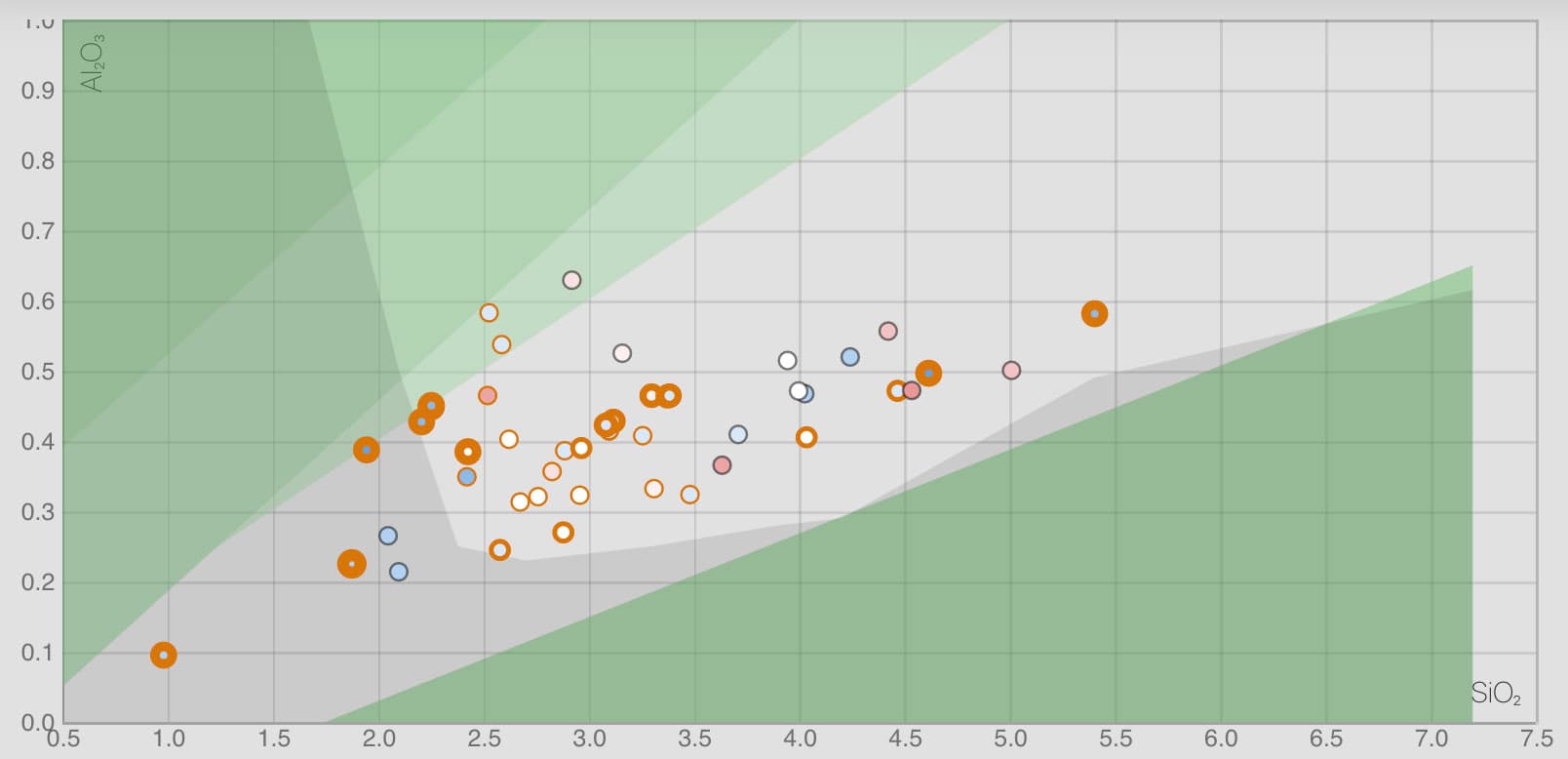
Each point representing a recipe has two color codings. The inner color of the point represents the R2O:RO Ratio, while the point outline represents the amount of Boron.
R2O:RO Ratio

The R2O:RO Ratio Scale shown in the Stull Chart.
The color of each recipe point denotes its R₂O:RO ratio. Recipes high in R₂O are redder, while recipes low in R₂O are bluer.
The ratio of R2O to RO oxides has implications for glaze stability and expansion.
More Stull Chart information: Robust Mid-Temperature Glazes and How Glazes Melt.
Boron Level
The outline of each recipe point represents the amount of boron. Recipes containing boron have an orange outline, and the thickness of the outline represents the amount of boron. Typically, glazes lower in temperature will contain more boron.

UMF Chart Trends
The following charts show all public Glazy recipes for Low-Fire, Mid-Fire, and High-Fire. Three trends stand out:
- The vast majority of recipes fall within the Stull “Bright” region.
- As recipes increase in temperature, so do their Silica and Alumina levels (points are located higher in the chart).
- As recipes decrease in temperature, Boron increases (orange outline thickens).

Stull Al/Si chart showing Leach 4321 analysis using different feldspars.
The following Stull chart shows the Leach 4321 recipe with different feldspar and kaolin analyses. You can see that by varying the types of ingredients (or the analyses of ingredients), the recipe will fall at different locations on the Stull Chart. It’s good practice to use actual ingredients with the most accurate analyses possible, for example using “Custer Feldspar” instead of the generic “Potash Feldspar” or “Feldspar”.
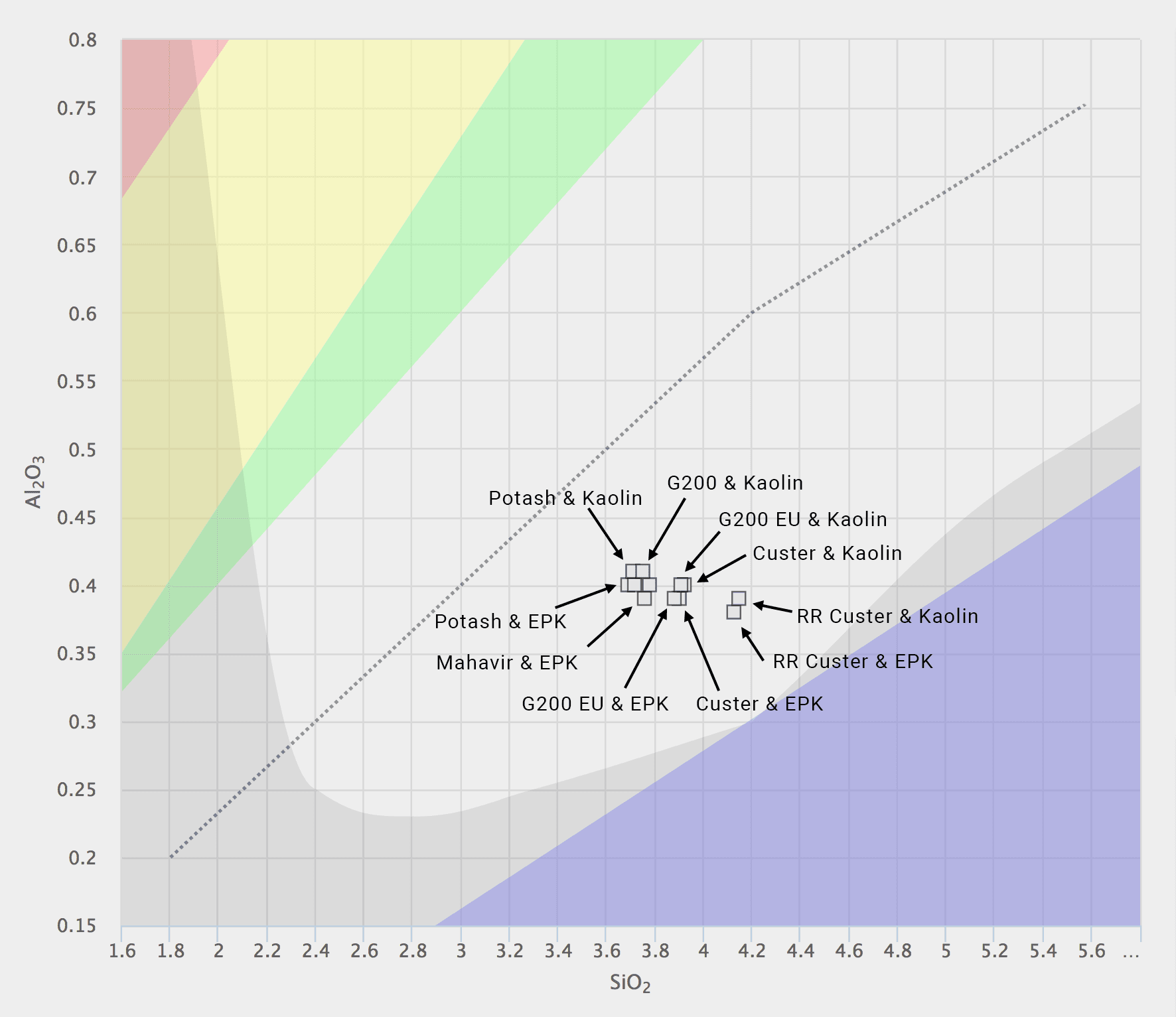
Using the Glazy Stull Chart
This video shows the basics of how to use the Stull Chart in Glazy:
Showing Limit Formulas
Glazy’s patron features allow layering various limit formulas like Cushing, Hesselberth & Roy, and Montmollin Fuse Diagrams. For more information, see Limit Formulas.

Screenshot of the Glazy Stull chart showing various limits: Δ5-6 Cushing Glossy, Δ6 Hesselberth & Roy, and Δ6 Green & Cooper.
Filtering the Chart
The chart can be filtered by using the form on the right. The recipe category can be changed (in the above screenshot, the category is Iron - Celadon - Blue), or the temperature can be filtered, or the axes of the graph can be modified.
The chart always loads as a plot of the oxides SiO₂ and Al₂O₃
Because the Stull Chart is based on SiO₂:Al₂O₃, it will disappear if you choose a different oxide pair.
Show Images
By clicking the “Show Images” checkbox you can display the thumbnail photos for each recipe in the graph. Please note that many recipes do not have photos and will only display as a greyed-out square.

Zooming in the chart
While the UMF Chart in the search can automatically be Pinched & Zoomed, the UMF Chart on the recipe page initially has Pinch & Zoom disabled in order to avoid accidental zooming.
Just click the “Allow Zoom” button to start zooming.

Similar Recipes & Analyses
Introduction to similar recipes and analyses in Glazy:
Similar Base Recipes

If two recipes consist of the same base materials (not including additional materials) in the same amounts (within 1%), then they are considered similar.
- Two Leach 4321 glazes (40% Feldspar, 30% Silica, 20% Whiting, 10% Kaolin) may be similar even if their additional oxides differ. For instance, Leach White is a 4321 glaze with added Zircopax, while Leach Celadon is a 4321 glaze with added iron. These two glazes are considered similar by Glazy.
- A Leach 4321 glaze recipe with 40% Potash Feldspar is similar to the same glaze recipe with 40% Custer Feldspar because the materials or their parent materials are the same.
- A Leach 4321 glaze recipe with 40% Potash Feldspar is not similar to the same glaze recipe with 40% Soda Feldspar because the materials (and their parent materials) are different.
- A Leach 4321 glaze recipe with 39.5% Feldspar and a Leach 4321 glaze with 40% Feldspar are considered similar because the material amounts only vary by %1.
Similar Analyses
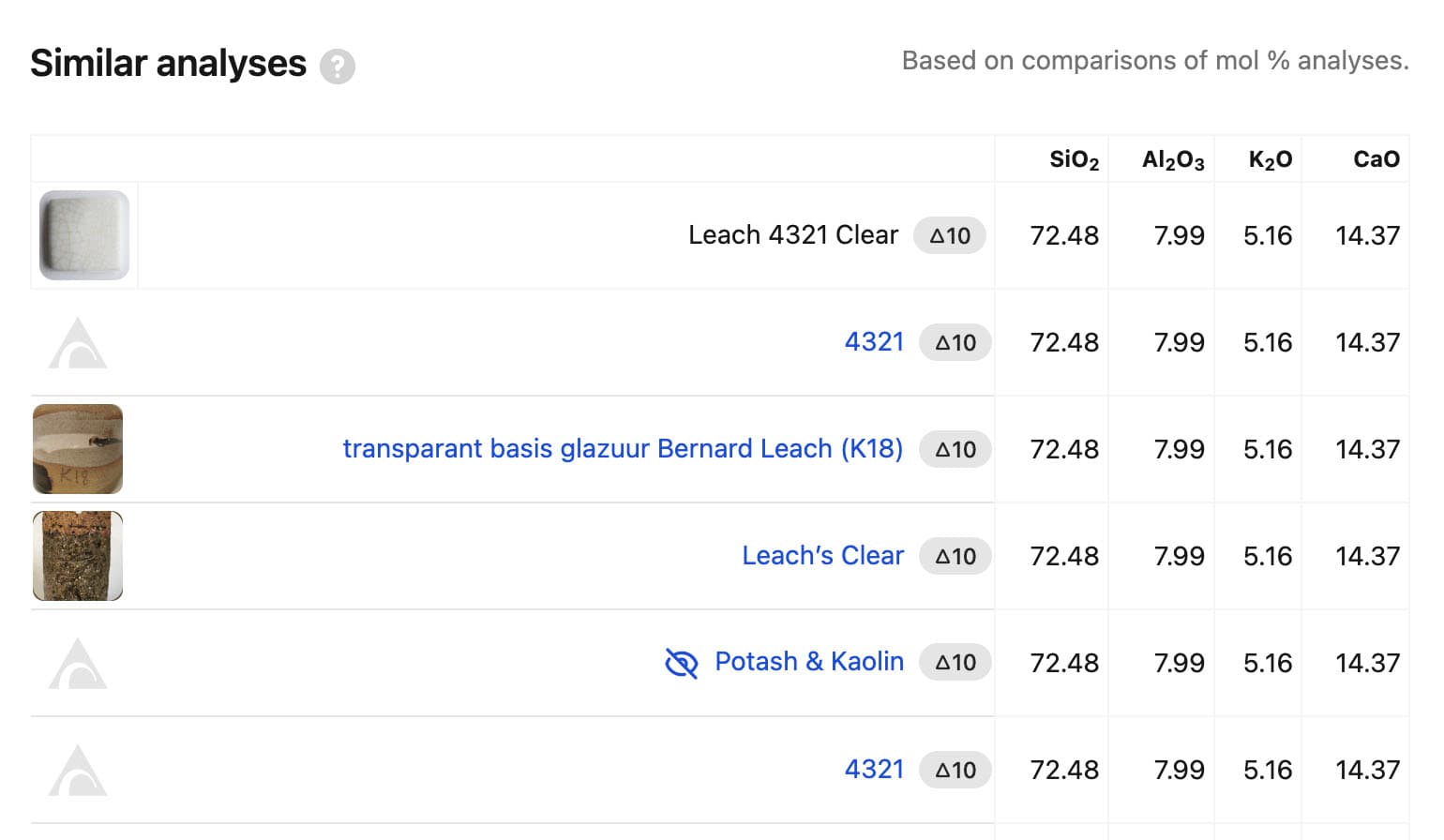
Two recipes are considered to have similar unity formulas if their oxides do not differ more than .05 For this comparison, K2O and Na2O are combined (KNaO).
Note: Recipes that have similar unity formulas do not necessarily exhibit similar fired characterisitics.
Oxide Coloring
Oxides are colored by their role in the UMF. The role of an oxide may change depending upon whether you are viewing Traditional UMF or Extended UMF.
Traditional UMF Coloring
R₂O Group: Na₂O, K₂O, Li₂ORO Group: PbO, SrO, BaO, ZnO, CaO, MgO, MnO
R₂O₃ Group: Al₂O3 B₂O₃ (Special Case) RO₂ Group: SiO₂, ZrO₂, SnO₂, TiO ₂Other Oxides: FeO, Fe₂O₃, MnO₂, P₂O ₅, F, CoO, Cr₂O₃, Cu₂O, CuO, NiO, V ₂O₅, ZrO, HfO₂, Nb₂O ₅, Ta₂O₅, MoO₃, WO₃, OsO₂, IrO₂, PtO ₂, Ag₂O, Au₂O₃ , GeO₂, As ₂O₃, Sb₂O₃, Bi₂O₃, SeO₂, La ₂O₃, CeO ₂, PrO₂, Pr₂O₃, Nd₂O ₃, U₃O8, Sm ₂O₃, Eu₂O ₃, Tb₂O₃, Dy₂O₃, Ho ₂O₃, Er₂O₃, Tm₂O ₃, Yb₂O₃, Lu ₂O₃
Extended UMF Coloring
R₂O Group: Na₂O, K₂O, Li₂O, Bi ₂O₃, CuO, SnO₂
RO Group: PbO, SrO, BaO, ZnO, CaO, MgO, MnO, Fe₂O₃, MnO ₂, CoO
R₂O₃ Group: Al₂O₃, TiO₂, NiO B₂O₃ (Special Case) RO₂ Group: SiO₂, ZrO₂Other Oxides: FeO, P₂O₅, F, Cr₂O₃, Cu ₂O, V₂O₅, ZrO, HfO₂, Nb ₂O₅, Ta₂O₅, MoO₃, WO ₃, OsO ₂, IrO₂, PtO₂, Ag ₂O, Au₂O₃, GeO₂, As₂O ₃, Sb ₂O₃, SeO₂, La₂O ₃, CeO₂, PrO ₂, Pr₂O₃, Nd₂O₃, U₃O8, Sm₂O₃, Eu ₂O₃, Tb₂O₃, Dy₂O ₃, Ho₂O₃, Er ₂O₃, Tm ₂O₃, Yb₂O₃, Lu₂O ₃
Exporting Recipes
Recipes can be exported as a Recipe Card- an image containing the recipe photograph, name, and recipe details.
Recipes can be exported to your favorite glaze calculation software. Currently, only Insight and GlazeChem are supported, but hopefully more export formats will be added in the future.
To export a recipe, simply select “Export” from the menu on the recipe page. The Recipe Card image can be saved on your computer or shared with others online. The downloaded glaze calculation software text file can be imported into your program.